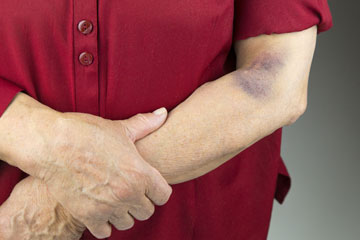Bruising is a normal response to an injury to an area of the skin. Bruises are caused when you fall, or someone hits you or you bump into something hard and the small blood vessels under the skin are damaged. Bruises occur because blood leaks out and has nowhere else to go. As the body heals and breaks down the hemoglobin, bruises will change in color. Generally, there are four phases of colors to a bruise before it fades away and the changing colors are a regular part of the healing process. Once the bruise has turned a light brown, it starts to fade.
Most bruises will go away after 2 weeks without treatment, while others will fade away after some time, depending on the damage. Here are some helpful tips to speed up the healing process and minimize the visibility of the injury:
- Use an ice pack: Placing an icepack or something frozen immediately on the injury helps reduce the amount of blood that leaks from the blood vessels into the tissues surrounding it. Wrap the ice in a piece of cloth or in a paper towel and place it on the fresh bruise. Ice the bruise for 10 minutes at a time, and wait for 20 minutes before reapplying. Applying ice can prevent severe discoloration.
- Heat application: If the bruise has already formed, applying a heating pad or a hot water bottle can help clear away the trapped blood and boost blood circulation. This will increase blood flow. Applying heat can also help to loosen tense muscles and relieve pain.
- Rest: When you are injured, stop what you are doing and take some time to assess the damage. If you bang your knee in the middle of a workout, stop doing it and rest. It will slow down the blood flow to your bruise and prevent the bruise from getting worse. Do not massage the sore spot as it can break more blood vessels under the skin and make the bruised area appear larger.
- Wrap it up: Placing pressure on the affected area can help ease any swelling caused by the bruise. It is best to use an elastic badge. Wrapping up the bruise firmly will squeeze the tissues and prevent the blood vessels from leaking. Take care not to wrap it up too tight.
- Raise the affected area: Raise the area affected to a comfortable position. This will helps relieve pain, drain fluid away from the bruised area, and prevent the bruise from getting bigger. Doing this can also reduce pressure and compression, and help the healing process as you rest and relax.
- Vitamin K cream: Vitamin K ointment can be bought over-the-counter. Vitamin K has properties to promote blood clotting and prevent blood loss. It can be used for subcutaneous bruises, especially on the face. Gently rub the cream onto the bruise at least twice a day.
- Aloe vera: Aloe vera is well-known for its anti-inflammatory properties. Apply pure aloe vera gel directly on the bruise.
- Ginger: Ginger is a great option to treat inflamed, injured skin. Wash the ginger thoroughly, and crush and apply it on the affected area. Hold it with a plaster and keep it overnight for the best results. Repeat this for a day or two.
- Follow a bruise-healing diet: A person’s diet has a great impact on his/her health. Eating a balanced diet with specific foods that keep you healthy can strengthen the body’s blood vessels and minimize bruising. The following foods can promote the healing process:
- Fresh pineapple can heal the bruise faster due to the bromelain content in pineapple.
- Apples, citrus fruits, red-onion, dark colored berries and cherries, and leafy green vegetables contains high amount of quercetin that promotes healing.
- Spinach, broccoli, lettuce, soybeans, and blueberries are sources of Vitamin K that can reduce bruising.
- Crab, lobster, legumes, spinach, and pumpkin seeds are sources of zinc and can strengthen the tissues and help the body heal.
- Eat protein-rich foods. Stick to those that are low in saturated fats and cholesterol like tofu, poultry, fish, etc.
Bruises usually heal on their own. However, if you continue to experience pain after three days, or if you develop a lump over your bruise or notice bruising for no reason, consult your doctor.
